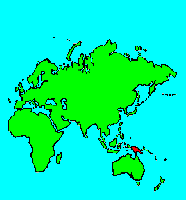SPECIES INFO
Northern New Guinea scrubfowl (Megapodius affinis to Megapodius decollatus) can be found along the lowlands of northern New Guinea. This species is related to M. freycinet, and some consider a subspecies thereof. Megapodius affinis is a gray colored bird.
There are no subspecies.Scrubfowl genus (Megapodius) is found from the Philippines south into Indonesia and then further east to New Guinea and further east into the Solomon Islands. and beyond. There is also a representative on Borneo. This genus is also found in northern Australia. There are also species on various islands near India. There were about 11 species per Monroe in 1993 two of which have recognized subspecies that might be considered species. In 2003 Howard and Moore listed 13 species. The changes are listed below.
Megapodius reinwardt ssp tenimberensis has become Megapodius tenimberensis (The Tanimbar scrubfowl). (adding one)
Megapodius affinis has become Megapodius decollatus (New Guinea Megapode). (name change, no count change)
Megapodius forsteri (Forster's Megapode) of Ceram and Buru is a new species. (adding one)
Megapodius gelvinkianus (Biak Megapode). Is a new species.(adding one)
Megapodius wallacei (Moluccan scrubfowl has become Eulipoa wallacei. (subtracting one)
Mound Builders (Family Megapodiidae) are a small group of 19 species (Monroe, 1993) of birds found from the Malaysian area to Australia and further east into Oceana. These fowl can appear like turkeys or large quail. Mound builders bury their eggs in mounds of debris, and some species regulate egg temperature by adding or subtracting additional debris. The young typically can fend for themselves upon hatching.
(Howard and Moore in 2003 counted 22 species.)
Fowl group (Galliformes order) contains the various chickens and turkey-like birds of the world. There are about 240 different species of fowl known. Many of the wild species are endangered. Several species such as the domesticated chicken and turkey are main food sources in the world. Most fowl are grain eaters and spend a good portion of their life searching for food on the ground. Select species have been domesticated for their beauty and/or edibility, others are considered good game birds.
Aves contains about 8,650 different species of living birds known to science. Each year about one new species is discovered in some remote rain forest or remote island. In addition, scientists have been raising many subspecies to full species status which may raise the species count to 10,000. Birdlife recognizes 10,027 species as of 2011.
However, each year about one species goes extinct. The rate of extinction is increasing, and the rate of new discovery is decreasing, so that the number of bird species will soon begin to decline rapidly. Although different taxonomists would organize the birds differently, there are approximately twenty-seven orders of birds. These orders are broken down into about one hundred and fifty-five different families.
Recent research of the genetic structure of some of the shore birds and owls would indicate that the present organization of orders and families should have some modification.
The birds are a worldwide group of animals that are characterized by having the front limbs modified into wings that are used for flying. Perhaps the most unique feature of the birds is the feathers. These feathers are made up of a central support called a quill and a series of small filaments that are hooked together as barbs.
For many years it was believed that Archaeopteryx discovered in Bavaria was the oldest bird from about 150 million years ago. However, in l986, Sankar Chattterjee, a Texas paleontologist, reportedly discovered a bird in the genus Protoavis that lived about 225 million years ago.
When this project was begun in 1978, we used Austin & Singer for bird taxonomy. Since then, we have adopted many changes, but have kept some older concepts that are still found widely in the literature. Recently, we have used Clements and Howard & Moore. Very recently, we have used Monroe and Sibley for the higher taxonomy of the perching birds.
Backboned Animals (Phylum Chordata) are the most advanced group of animals on earth. These animals are characterized by having a spinal cord or backbone. Most members have a clearly defined brain that controls the organism through a spinal cord. Fish, amphibians, reptiles, birds, and mammals are in this phylum.
Currently, some taxonomists believe that the fish should be divided into two groups (sharks and regular fishes) and that there are some other primitive groups in the phylum such as hagfish or lampreys.
Animal Kingdom contains numerous organisms that feed on other animals or plants. Included in the animal kingdom are the lower marine invertebrates such as sponges and corals, the jointed legged animals such as insects and spiders, and the backboned animals such as fish, amphibians, reptiles, birds, and mammals.

